There are two Sago palm species in Papua New Guinea. Metroxylon sagu Rottb. and the other one occurs in North Solomons Province and the Solomon Islands. Its scientific name is Metroxylon salomonense.
The sago palm plant
The sago palm grows up to 10 or 25 m tall and is nearly a meter across the trunk. It produces suckers around the base. After about 15 years the main trunk produces a very large flower at the top and then the trunk dies. The center of the trunk is filled with starch. The plant also produces useful building materials. The fronds are very good house roofing material.
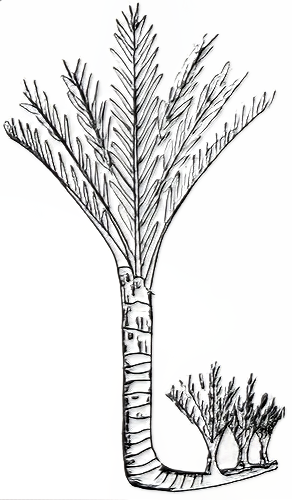
Where does it grow?
The sago palm common in Papua New Guinea also grows in Indonesia and Malaysia. Sago palms grow in the lower areas, up to about 1200 m.
It is very important in the Sepik and Fly River areas, in the transFly- and in many coastal areas such as along the Papuan coast and Gulf region.
In the Southern Highlands in the Kutubu area (Foi and Fasu) sago is the staple food. In other lowland areas, it forms an important supplementary staple but not the main food. But sago isn’t planted just anywhere in these places, it is planted in special sago sites. Often these are along the banks of creeks, like in the Kaluli area, or the bottoms of valleys such as the Kerabi Valley near Erave. At Kutubu, the sago groves fill up large swamps. People establish and care for sago groves and these are often at some distance from the villages, as people prefer to live in drier places.
Sago doesn’t like to be in a very wet swamp and doesn’t like to be in a dry place. Often sago sites are just slightly too wet for gardening.
Varieties of sago
People in Hegiso village near Kutubu recognize and have names for at least 34 varieties of sago. These vary from having no thorns, up to ones with very long thorns on the bases of the fronds. The height, shape, toughness of the bark, and length of the fronds vary. Some palms mature quickly, some have many suckers and the taste and colour of the starch varies. In other areas, the people only recognize a few kinds of sago.
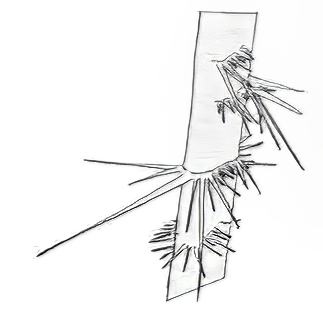


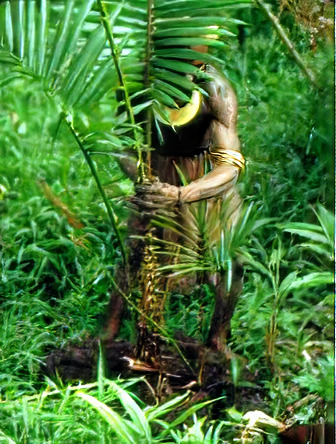

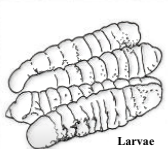
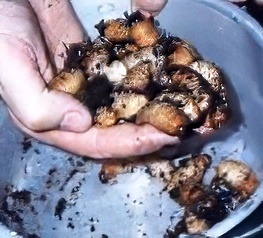
Planting sago
In the Southern Highlands, practically all sago is planted. One or two varieties will grow fairly easily from seed, but most kinds are planted from suckers.
To plant sago, the planting site near a creek or in a damp place is first cleared of trees and rubbish. Then a sucker of a suitable variety is chosen from an old sago clump. Often the fronds of the sucker are up to 3 m high. It is first checked to see if the sucker is old enough. Suckers ready for planting have a tough woody connection to the base of the old palm. This is chopped through with an axe. The sucker is then simply taken to a new site and planted in a shallow hole. If several palms are being planted, they should be about 7 m apart. The only other attention the new palm needs is an occasional weeding to cut back rubbish when it gets too thick.
Growth of sago palms
It takes 12 to 15 years for a sago palm to grow big enough to cut down. Palms in poor soil grow more slowly.
Normally, one main trunk grows up, but several small suckers may shoot up around the base. Sometimes these suckers spread out and the space between the palms becomes crowded. Too much competition between clumps slows down the growth of the main palm, so the grove needs to be thinned out. This is very easily done. A small hole (10 cm x 10 cm) is cut with an axe into the top of the trunk of a sucker that is not wanted. This hole lets the sago beetle in and the sago grubs that develop quickly kill out the sucker. They don’t get into the main palm or other suckers unless a hole is made. After a few months when the sucker is seen to be dead, it can be split open to provide a feed of sago grubs.
There is no simple way of telling when a palm is ready to harvest. By experience, people learn to recognize how big each variety should be before it is ready to harvest. If the palm were left too long it would produce a very large flower at the top and then die. This flower would use up all the starch in the trunk so that there would be nothing to harvest. As long as the flower has only started to grow and the seeds haven’t yet formed on it, the palm is still suitable for harvesting.
Sometimes when people are in a hurry to use a palm that isn’t quite ready, they cut a hole to check how much starch is stored inside. But sago grubs must not be allowed to get in. After the palm has been cut and harvested another sucker grows more quickly than the others and becomes the new main trunk. It still takes about the same time to get mature.
Harvesting sago starch
First, the sago palm is cut down. Mostly this is men’s work. Then the bark is split off the trunk for about one meter along its length. Normally this bark is carefully laid out at the sides propped up by logs so that it both makes a seat for the person to sit on and a mat for the shredded pith of the trunk to fall onto.
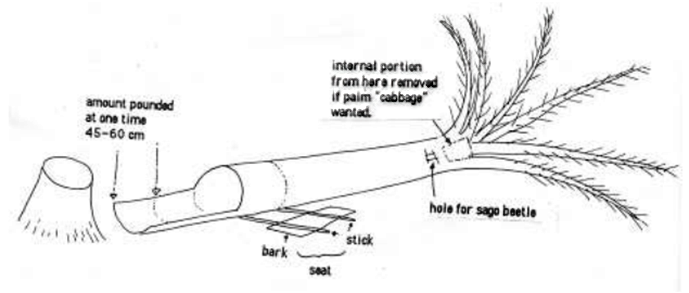
Sago harvesting process
Sago in the trunk of the palm is all mixed up with the fibers of the plant. So, this pith has to be shredded up into small pieces and the starch is then washed out. Special tools are made for pounding up the trunk. They need to be light, strong, and with a hard stone (or metal) head. In areas where sago is the main food, sago is women’s work. The women sing special songs while they work. In areas where sago is not the main food, both men and women pound sago.

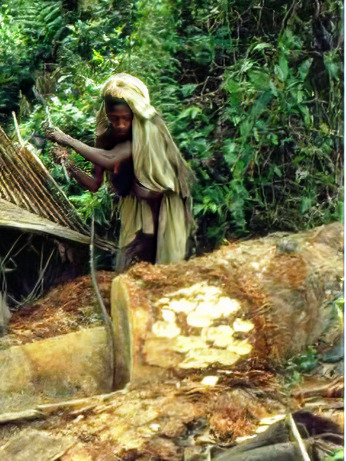
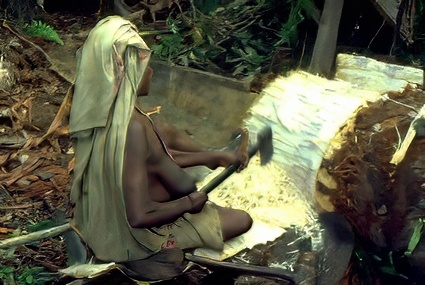
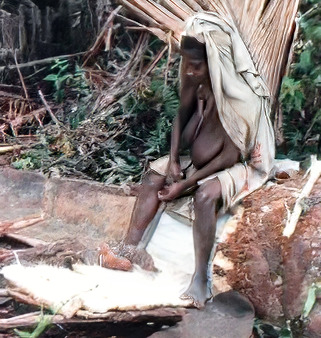
The normal method of pounding sago is to sit at the side of the trunk, hold the sago pounder in both hands and lift it above your head, then chop it down so that it just scrapes a thin layer off the edge of the trunk. When a pile of shredded-up trunk has been made, this is carried away to be washed. If a lump of the pith breaks off it is often chopped up with a bush knife or axe.
Sago washing

A framework is set up for washing sago. It needs to be near water. If no convenient creek is nearby, a hole can be dug in the ground as this quickly fills with water in most sago places. The water needs to be clean, or the starch gets a bad color and taste.


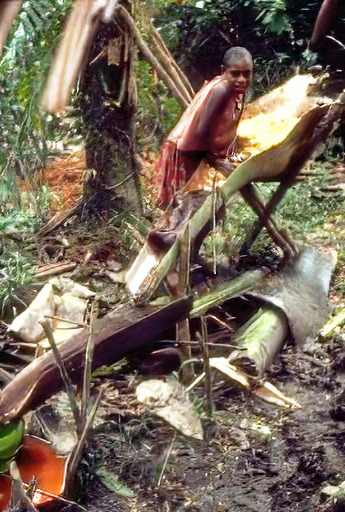
The washing framework is mostly built using the bottom section of the midrib of the sago fronds. The shredded pith of the palm is put into the bowl made by the fronds and the starch is washed out by banging it with a stick and pouring water over it. The filtered starch is allowed to settle out in a bowl. It is then dried and taken home.
Sago storage


Some people store sago for long periods. The sago to be stored is wrapped up in a tight bundle using leaves and bark. It is then buried in the mud. It will keep for one or two years. Sago that has been stored has a slightly different taste, but it is still quite good to eat. The unprocessed sago logs can be stored in water for a considerable time. This is common along the Sepik River.
Sago cooking
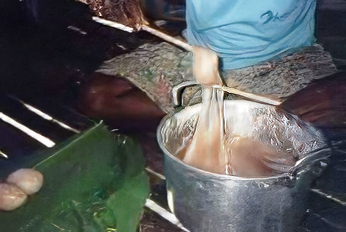
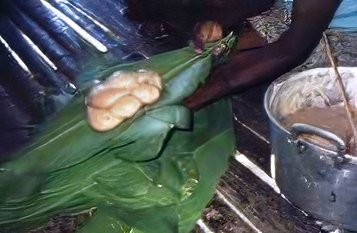

In some areas, people simply fill up a bamboo tube with sago starch and bake it near the fire. Sometimes sago is cooked and wrapped in leaves. The bamboo tube is then split open and the sago is eaten, along with greens and other foods. Occasionally people add leaves such as “Tu-lip” leaves, or Okari nuts. Sago pancakes are made by spreading sago out in a hot curved frying pan and then placing another hot pan over it. Sago is often made into a porridge by dropping sago into hot water. There are lots of other interesting ways sago can be cooked and used, but people in some areas don’t seem to use these.
Extra food from sago
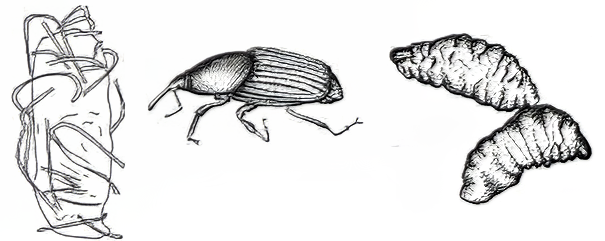
At the top of the trunk of a sago palm, there is a bundle of young tender undeveloped leaves. This is often called the palm “cabbage”. It can be cut out cooked and eaten. It is good food.
Sago grubs and sago starch go together. Sago grubs are grown in several different ways in sago areas. Normally the top and bottom sections of the trunk are left for sago grubs to grow in as these sections have less starch and more fibre and are therefore harder to work. As already described, sago grubs are grown in suckers that are being killed. If too many palms are ready at one time, the extra ones are cut down for grubs to grow in. Sometimes a poor-tasting or very fibrous palm is left for grubs to grow in. Particularly near Bosavi, sago grubs are also cultivated in another palm called the fishtail palm (waiyo). It takes about 2 months for a harvest of grubs from the time the beetles are first let into the palm.
Sago grubs are the larvae of a beetle. (Rhyncophorus spp.) They are good food being both enjoyable and having good food value.
Sago as food
Sago is a very good energy food. But it has very little of the growth food (protein) or health food (vitamins and minerals). Therefore, in sago areas, it is particularly important to pay special attention to the other foods that make up the diet.
The food value of 100 g of the food eaten is:
| Moisture % | Energy cals | Protein g | Calcium mg | Iron mg | pro-Vit A mg | pro-Vit C mg |
| starch | 20-45 | 285 | 0.2 | 30 | 0.7 | |
| grubs | 70.5 | 181 | 6.1 | 461 | 4.3 |
Yield and work required
One sago palm may last an average family (6 people) for 4 weeks. It is worked in sections of 60 cm to 100 cm of the trunk and 6 to 8 of these sections can be taken from one palm. A typical routine would be for a woman to spend 3-4 hours pounding and washing one section and this would produce about 20-25 kg of starch that would last the family for about 3 days.
Pest and Disease
Sago diseases
| Sooty mould | Fungus | Borinquenia sp. |
| Parallel-sided leaf spot | Fungi | Melanographium sp |
| and | Tripospermum sp | |
| and | Zygosporium gibbum | |
| Parallel sided leaf spot | Fungus | Sphaerulina sp. |
| Leaf spot | Fungus |
Sago insect pests
| Asiatic rhinoceros beetle | Oryctes rhinoceros (L.) |
| Cane weevil borer | Rhabdoscelus obscurus Boisduval |
| Coconut leaf miner | Promecotheca papuana Csiki |
| Palm weevils | Rhynchophorus bilineatus (Montr.) |
| Rhynchophorus ferrugineous (Oliv.) | |
| and | Rhynchophorus papuanus Kirsch |
| Taro beetles | Papuana spp. |
| Agapophyta bipunctata Boisd. | Pentatomidae (HEM) – a bug reported on coconut and sago. |
| Trochorhopalus strangulatus Gyllenhal | Curculionidae (COL) – a weevil reported from dead sago palm. Adults and larvae boring into the lower 40 cm of the false stem of bananas causing heavy damage over a limited area in the central province. |
| Leptococcus metroxyli Reyne | Pseudococcidae (HEM) On sago, pineapple, coconut |
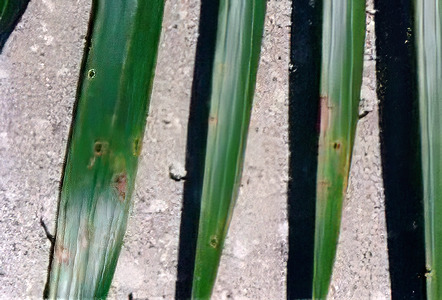
Leaf spot on sago
________________________________________________________________________________________________________________
Text and all photos at this article © Food Plant Solutions. The professional background and contact information of the author of this article can be found here.
.



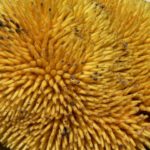
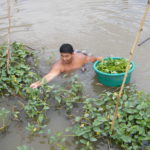
2 comments
terence
Observing traditional cultural practices is of great significance
Kurt Hoelzl
I share your opinion! Please also preserve, practice, and record these cultural practices in your surroundings.